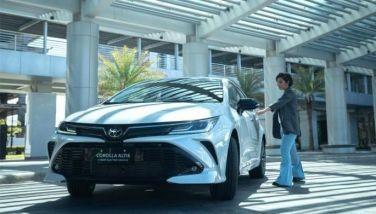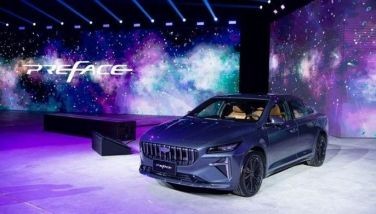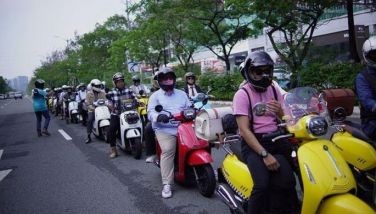Jeepney goes electric
October 2, 2002 | 12:00am
Ask any foreigner who ever visited the Philippines what the principal mode of transportation in this country is and chances are he will show you a handmade miniature jeepney he got as a souvenir.
No doubt, the jeepney has become a Philippine icon, embodying everything – good and bad – about Filipino life. It is practical, easy to maintain, has a festive design, and can carry the whole clan or even the entire barangay to anywhere, come hell or high water.
But the jeepney is dying. Its market has been eaten up by more comfortable (read: luxurious) Asian and sport utility vehicles. Two years ago, Sarao Motors, the company whose name is most synonymous to jeepney-making, closed down, blaming the government for its lack of protection and incentives. At the rate jeepney sales are going, the industry seems to be doing a full circle by going back to the backyard talyers where it all started.
Comes now Francisco Motors Corp. (FMC), the oldest existing jeepney-making company in this land. Once considered the country’s second biggest manufacturer of jeepneys (its founder was even once hailed as the Henry Ford of the Philippines), FMC has come up with an innovation – a jeepney that runs completely on batteries.
The electric jeepney, as the vehicle is called, has been in the development stage since 1998. It was the vision of the late senator Raul Manglapus to produce the first Filipino electric vehicle to minimize pollution in the country. Known for being a nationalist, Manglapus put up the Centennial Philippine Motor Corp. (CPMC) as well as the Filipino Car Foundation to make his vision a reality.
The 18-seater white jeepney with blue, yellow and red stripes and a half sun on the side is FMC’s third attempt at producing an electric vehicle. The first attempt was a smaller jeepney, then the second was an Anfra AUV that still runs until now. In fact, it was the Anfra which fetched The STAR’s photographer from the FMC gates.
The electric jeepney’s appearance is very similar to the traditional jeepney. However, under its bare hood (sorry, no metal horses here) whirs a 20-horsepower DC motor that FMC bought from the United States.
The motor gets its power from the 16 batteries that is lined up in a series under the jeepney’s flooring. With its still very limited power, the vehicle can only run for 50 kilometers at a maximum speed of 55 kilometers per hour. It is not that impressive compared to electric vehicles in more advanced countries. But hey, with the traffic, who needs a fast jeepney?
Jun Fermin, product development engineer at FMC, said one needs simply to plug the vehicle to an electric outlet to charge its batteries. "The batteries need five to eight hours to be fully charged to 96 volts," he said. "The batteries were also imported from the US but now there is a Korean firm that makes it here."
Fermin accompanied The STAR for a test ride on the electric jeepney. Fully charged and ready for display at the Motorshow International at the World Trade Center today, the jeepney accelerated smoothly, with no noise whatsoever, making its occupants feel as if they were riding a push cart. "Is the motor running already?" they asked Fermin. He, too, was a bit disoriented. "I think so. We’re moving."
There are two pedals on the driver’s side, one to get the vehicle moving and the other to put it to stop. Fermin pressed a switch on the flat dashboard to go on reverse. "This is very simple. It’s very much like a golf cart," he said.
Fermin said three chains transfer the power from the motor to the front wheel differential. At night, the battery runs shorter since the headlamps and rear lamps consume some of the power.
The electric jeepney was developed to the tune of P600,000, almost double the cost needed for a traditional jeepney. The funding was provided by Manglapus’ CPMC, which, incidentally, has FMC head Antonio Francisco on the board.
Despite its achievement with the electric jeepney, FMC remains in dire straits as a company. After 55-years of producing millions of people haulers, it is struggling to keep both ends meet, having lost the franchise to make Mazda pickups and vans (it has a pending legal battle against Ford Motor Co.) and the right to assemble and market Hyundai vehicles. It is now running on slow mode to remain afloat.
Aside from jeepney making, which has vastly slowed down, FMC derives revenues from the remanufacture of Korean engines that it markets to owners of jeepneys and Anfras. But again, this may not be enough to keep FMC alive.
Sources within the company say FMC now operates only on half capacity after cutting its workforce by more than 40 percent due to low market demand. Its employees now report to work three days in a week and they build only an average of six units of jeepneys a month. Such is a pathetic figure considering the size of FMC’s plant in Las Piñas.
Can the electric jeepney recharge FMC’s dwindling batteries? Can it save the jeepney from becoming a mere souvenir item from the Philippines? Can it finally put this country in the automotive map of the world?
The odds are too low to be considered electrifying.
No doubt, the jeepney has become a Philippine icon, embodying everything – good and bad – about Filipino life. It is practical, easy to maintain, has a festive design, and can carry the whole clan or even the entire barangay to anywhere, come hell or high water.
But the jeepney is dying. Its market has been eaten up by more comfortable (read: luxurious) Asian and sport utility vehicles. Two years ago, Sarao Motors, the company whose name is most synonymous to jeepney-making, closed down, blaming the government for its lack of protection and incentives. At the rate jeepney sales are going, the industry seems to be doing a full circle by going back to the backyard talyers where it all started.
Comes now Francisco Motors Corp. (FMC), the oldest existing jeepney-making company in this land. Once considered the country’s second biggest manufacturer of jeepneys (its founder was even once hailed as the Henry Ford of the Philippines), FMC has come up with an innovation – a jeepney that runs completely on batteries.
The electric jeepney, as the vehicle is called, has been in the development stage since 1998. It was the vision of the late senator Raul Manglapus to produce the first Filipino electric vehicle to minimize pollution in the country. Known for being a nationalist, Manglapus put up the Centennial Philippine Motor Corp. (CPMC) as well as the Filipino Car Foundation to make his vision a reality.
The 18-seater white jeepney with blue, yellow and red stripes and a half sun on the side is FMC’s third attempt at producing an electric vehicle. The first attempt was a smaller jeepney, then the second was an Anfra AUV that still runs until now. In fact, it was the Anfra which fetched The STAR’s photographer from the FMC gates.
The electric jeepney’s appearance is very similar to the traditional jeepney. However, under its bare hood (sorry, no metal horses here) whirs a 20-horsepower DC motor that FMC bought from the United States.
The motor gets its power from the 16 batteries that is lined up in a series under the jeepney’s flooring. With its still very limited power, the vehicle can only run for 50 kilometers at a maximum speed of 55 kilometers per hour. It is not that impressive compared to electric vehicles in more advanced countries. But hey, with the traffic, who needs a fast jeepney?
Jun Fermin, product development engineer at FMC, said one needs simply to plug the vehicle to an electric outlet to charge its batteries. "The batteries need five to eight hours to be fully charged to 96 volts," he said. "The batteries were also imported from the US but now there is a Korean firm that makes it here."
Fermin accompanied The STAR for a test ride on the electric jeepney. Fully charged and ready for display at the Motorshow International at the World Trade Center today, the jeepney accelerated smoothly, with no noise whatsoever, making its occupants feel as if they were riding a push cart. "Is the motor running already?" they asked Fermin. He, too, was a bit disoriented. "I think so. We’re moving."
There are two pedals on the driver’s side, one to get the vehicle moving and the other to put it to stop. Fermin pressed a switch on the flat dashboard to go on reverse. "This is very simple. It’s very much like a golf cart," he said.
Fermin said three chains transfer the power from the motor to the front wheel differential. At night, the battery runs shorter since the headlamps and rear lamps consume some of the power.
The electric jeepney was developed to the tune of P600,000, almost double the cost needed for a traditional jeepney. The funding was provided by Manglapus’ CPMC, which, incidentally, has FMC head Antonio Francisco on the board.
Despite its achievement with the electric jeepney, FMC remains in dire straits as a company. After 55-years of producing millions of people haulers, it is struggling to keep both ends meet, having lost the franchise to make Mazda pickups and vans (it has a pending legal battle against Ford Motor Co.) and the right to assemble and market Hyundai vehicles. It is now running on slow mode to remain afloat.
Aside from jeepney making, which has vastly slowed down, FMC derives revenues from the remanufacture of Korean engines that it markets to owners of jeepneys and Anfras. But again, this may not be enough to keep FMC alive.
Sources within the company say FMC now operates only on half capacity after cutting its workforce by more than 40 percent due to low market demand. Its employees now report to work three days in a week and they build only an average of six units of jeepneys a month. Such is a pathetic figure considering the size of FMC’s plant in Las Piñas.
Can the electric jeepney recharge FMC’s dwindling batteries? Can it save the jeepney from becoming a mere souvenir item from the Philippines? Can it finally put this country in the automotive map of the world?
The odds are too low to be considered electrifying.
BrandSpace Articles
<
>
- Latest
Latest
Latest
August 16, 2024 - 11:00am
By Euden Valdez | August 16, 2024 - 11:00am
June 18, 2024 - 2:55pm
June 18, 2024 - 2:55pm
Recommended

























